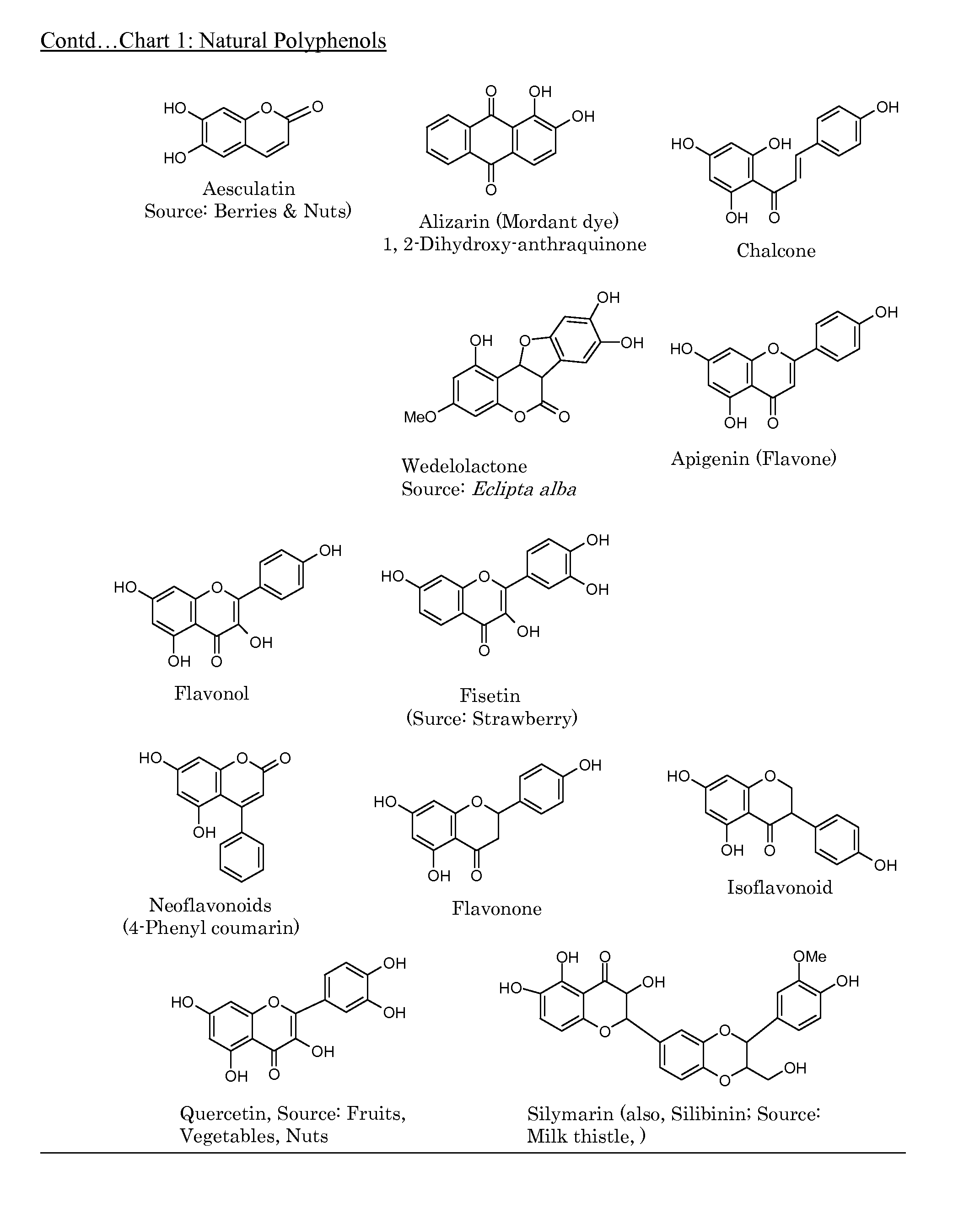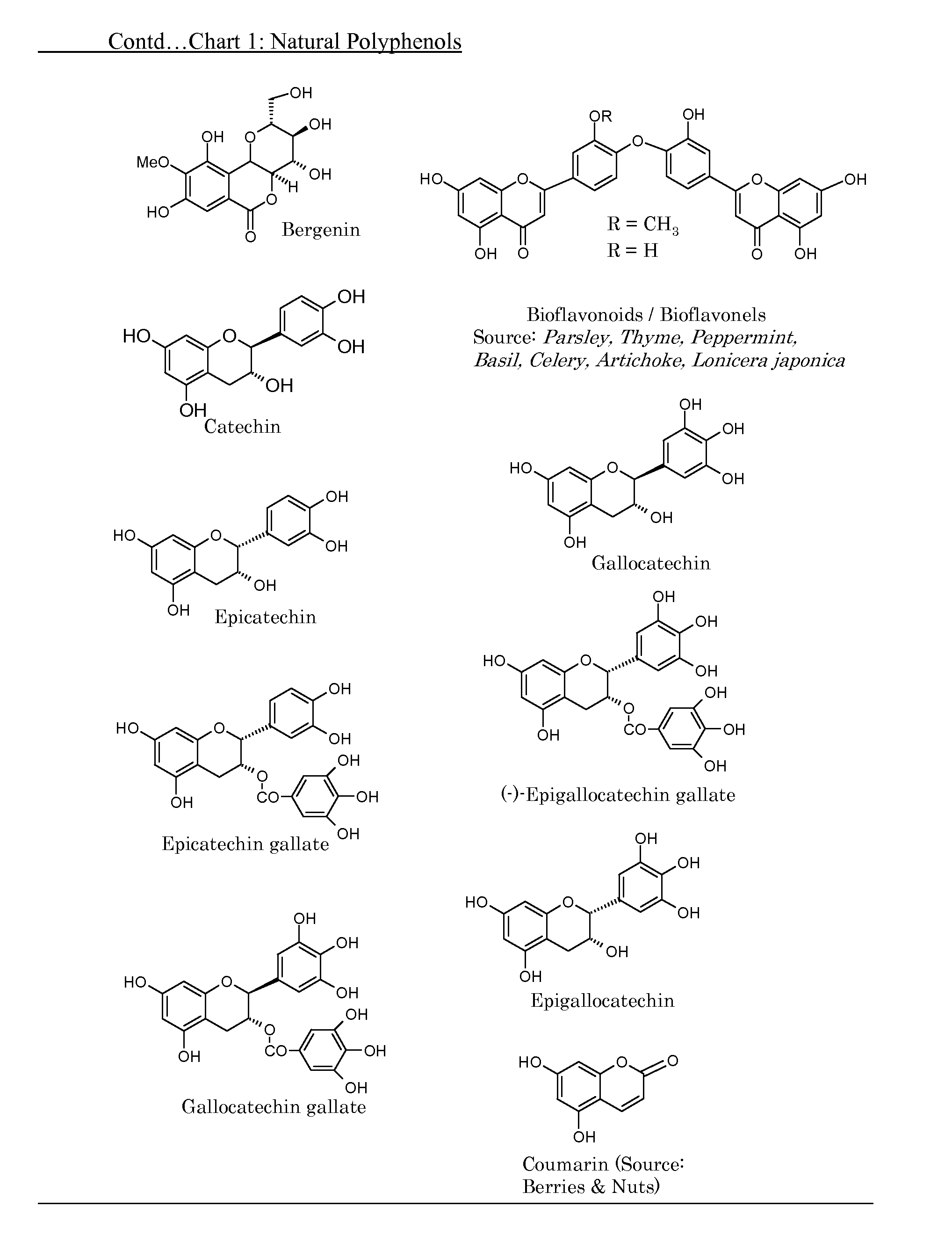Biocompatible and biodegradable polymers from renewable natural polyphenols
a biodegradable and natural polyphenol technology, applied in the field of biocompatible and biodegradable polymers from renewable natural polyphenols, can solve the problems of inability to make polymers from renewable sources (especially non-petroleum sources) and the difficulty of finding a replacemen
- Summary
- Abstract
- Description
- Claims
- Application Information
AI Technical Summary
Benefits of technology
Problems solved by technology
Method used
Image
Examples
embodiments
[0073]One major embodiment of the present invention is to make polymers from relevant phenolic compounds that can be obtained from natural sources thus providing alternative polymeric material that are safer to the consumer and less burdensome to the environment by being biocompatible, biodegradable and non-toxic.
[0074]A second embodiment is to make suitable ‘derivatives’ of natural phenols, e.g, allyl derivatives of the phenols, and use them as such and in combination with appropriate commercially available ‘building block’ monomers to make copolymers.
[0075]The third embodiment is to use existing, already established and popular industrial processes to make copolymers by combining one or more of natural polyphenols with other commercially known, well accepted compounds (monomers) thus providing newer, natural polyphenol embedded, biodegradable and safer copolymers.
[0076]A fourth embodiment is to firstly, make block copolymers by combining two types of oligomers made from structural...
example 1
[0120](E,E)-1,7-Bis(4-O-allyloxy carbonyl-3-methoxy phenyl)-1,6-heptadiene-3,5-dione (1, Curcumin diallyl carbonate).
[0121]Curcumin, CCMN (6.5 g, 17.6 mmol) is dissolved in N, N-DMF (60 mL) and stirred at r.t. (23° C.) over molecular sieve 4A (40 min-1 h). The stirred solution is cooled (0-5° C.) and a solution of allyl chloroformate (4.6 mL, 43.4 mmol) in N,N-DMF (5 mL) was dropped into it over 20-30 min. After the usual work up, the chloroform solution on evaporation gave a crude solid which was recrystallized from ethyl acetate-hexane to give pure 1 (5.88 g, Rf 0.125 in Hexane-Ethyl acetate-Methanol 4:1:0.1 v / v; yield 62%). More 1 could be isolated from the mother liquor.
[0122]1H-NMR (ppm, CDCl3). 7.6 (d, 2p); 7.15-7.11 (6p, aromatic); 6.55 (d, 2p); 6.25-5.94 (m, 2p, CH═); 5.85 (s, enol H); 5.45-5.29 (4q, 4p, ═CH2); 4.76-4.72 (2t, 4p,allylic OCH2—); 3.89 (s, 6p, OCH3).
example 2
[0123]1,7-Bis(4-O-allyloxy carbonyl-3-methoxyphenyl)-heptane-3,5-dione (2). Tetrahydrocurcumin, THCCMN (1.0 g, 2.68 mmol) is dissolved in a solution of dichloromethane (DCM, 8 mL) admixed with pyridine (1.5 mL) and stirred at 0-5° C. over molecular sieve 4A (30min). A solution of allyl chloroformate (0.85 mL, 8.01 mmol) in DCM (1.0 mL) was dropped into it over 20-30 min while continuing the stirring. TLC (Hexane-ethyl acetate 1:1 and 2:1) after 30 min showed no starting material, one major and a minor product . Ethanol (1.0 mL) was added, stirred (30 min) and the reaction mixture filtered under suction through a bed of Celite. The organic solution was washed with cold aqueous HCl (1N), water, aqueous sodium bicarbonate, dried (MgSO4), filtered and evaporated to give a syrup. Column chromatography using pre-packed silica column (80 g) and eluting with Hexane-Ethyl acetate (1:1, 70 mL and 7:2 gave first the minor product followed by 2, the major product.
[0124]1H-NMR, 2 (ppm, CDCl3). 7...
PUM
 Login to View More
Login to View More Abstract
Description
Claims
Application Information
 Login to View More
Login to View More - R&D
- Intellectual Property
- Life Sciences
- Materials
- Tech Scout
- Unparalleled Data Quality
- Higher Quality Content
- 60% Fewer Hallucinations
Browse by: Latest US Patents, China's latest patents, Technical Efficacy Thesaurus, Application Domain, Technology Topic, Popular Technical Reports.
© 2025 PatSnap. All rights reserved.Legal|Privacy policy|Modern Slavery Act Transparency Statement|Sitemap|About US| Contact US: help@patsnap.com



